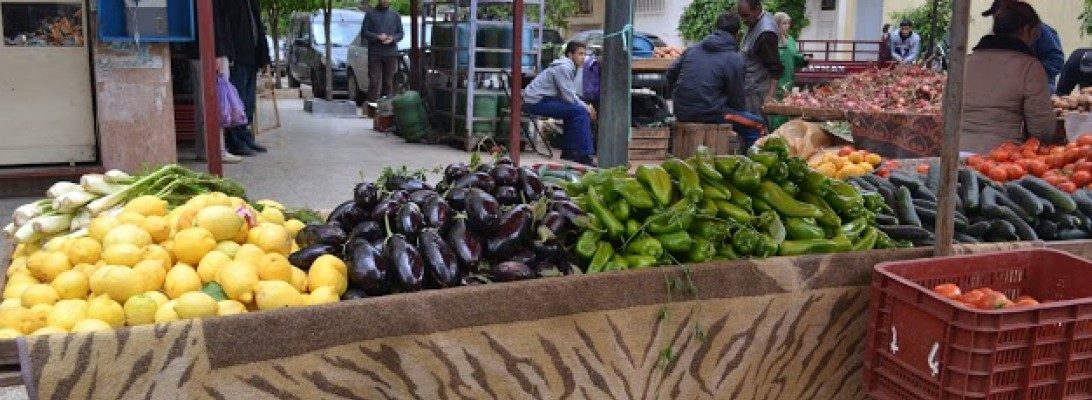Life here in Morocco is often made more interesting, occasionally even causing us to marvel, due to the element of surprise. Becoming aware of something totally new or unexpected can confront us when we least expect it. It could be nothing more than being surprised that we ran into an acquaintance we haven’t seen in 15 years and they remembered us, or that we made it home in the taxi without being involved in an accident even though the driver was texting on his smart phone half the time. A particularly unusual surprise occurred this past Monday afternoon when I went out for a walk in our neighborhood just to get some exercise.
Perhaps you remember that we are located within a fairly concentrated population. The block in which the apartment is located is one of six six-story buildings each attached to one another. The first two stories are devoted to commercial enterprises and the top four have two apartments each. Thus there are eight apartments in each building or forty-eight on our side of the street. Behind our row of apartments is a similar arrangement facing the other direction constituting another forty-eight which gives a total of ninety-six apartments bounded by the four streets forming the boundary of the block in which we live. There is at least an average of three people per apartment; thus almost three hundred people reside in our block and there are at least ten blocks laid out just like ours resulting in a population of approximately three thousand people on our side of the boulevard called Charia Wafa. Within a circular area of diameter of about two miles, one can easily find fifty such apartment buildings or more, resulting in a population of over 150,000 in an area that would be roughly three square miles. Compared to what we are used to in our suburban city of Hoover, population 84,126 as of the 2013 US Census estimate, we are in a much more densely populated area.
Though our neighborhood is not an incorporated suburban town, it is probably six or seven miles from the center of the city. Thirty years ago a large percentage of the residential housing in this part of town did not exist; it was still primarily agricultural. Furthermore the municipal growth has continued well beyond the confines of Narjiss, the name of our neighborhood, so that we are not technically an “exurb.” That is why I found it surprising when for my walk I took a totally new route directly behind our residence and came across a field of wheat. It was not a golden wave of grain, but given the time of year, a very aesthetically pleasing shade of green. Less than a quarter mile away I saw a very up-scale home with a long driveway lined with olive trees connecting to the boulevard. Beyond the trees on the far side, I saw another field of wheat of approximately the same size. Apartment buildings and commercial establishments extended for several hundred more yards beyond that field.
I could not believe that in this sea of humanity, there could be that amount of land that had gone undeveloped and that the owner had resisted the temptation to reap the financial reward likely available to him. Not being too pressured for time, I stepped off two sides of the almost rectangular plot, and estimated that it contained at least thirty acres. I am not sure how much the land would be worth, but given the population growth in this city over the past three decades, it must be an enormous sum.
Stunned as I was to find this green area just three blocks from our residence, I was even more astounded when I noticed animals grazing out in the nearer field that served as a pasture. I thought my eyes deceived me, but there were seven camels, minding their own business, abiding in the field and lazily chewing their cud. They obviously were not at all worried about being surrounded by so many people.
I have seen a few camels near Fes over the years I have lived and visited here, but usually in the service of the travel industry where photographs of tourists were being made. We have a video of Denise made in 1972 riding a camel who was coaxed into running by his handler. In the seventies I saw a camel being used as a plow animal, yoked with a mule, on a farm near the city of Kenitra where we lived at the time. Denise and I even took a desert trip with friends in 2011 and rode camels out to a bivouac area where we spent the night in a tent in the desert. But Fes is over 200 miles from the desert while this situation seems to be part of an agricultural pursuit.
The camels here in Morocco are all dromedary, or one-hump camels. Although I mentioned the camels I observed seemed to be eating all the time, or at least chewing their cud, camels are not true ruminants like cattle. Wikipedia informs me that true ruminants have four chambers in their stomach while a camel only has three. Friends here told me that in the old part of the city camel meat is available in the markets and the hides of camels are used in the renowned Moroccan leather industry. I have no idea what the future holds for these camels I happened upon by accident.
Since Monday I have made the three block walk several times up to the field to watch the camels. In the greater scheme of things I suppose it is not a very big deal. But I confess that finding a large field of wheat being cultivated in the middle of the city, complete with a substantial large animal exhibit, completely surprised me. Life is often very interesting here!
Fred
(pictures by Fred; formatted by Denise)



